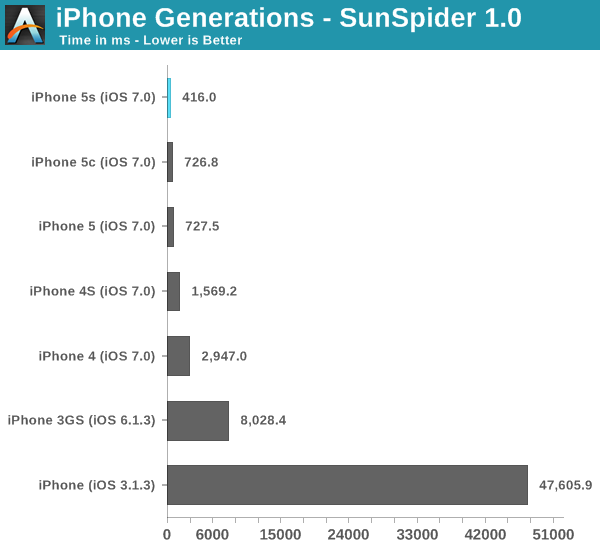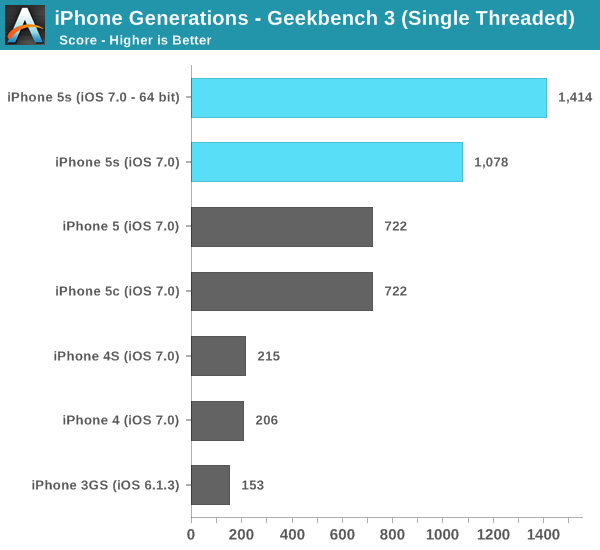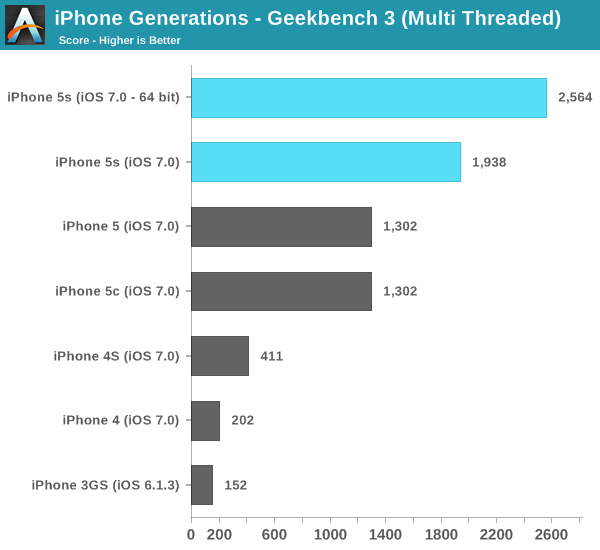The iPhone 5s Review
by Anand Lal Shimpi on September 17, 2013 9:01 PM EST- Posted in
- Smartphones
- Apple
- Mobile
- iPhone
- iPhone 5S
iPhone Performance Across Generations

Performance improved by a factor of 100x compared to the original iPhone. You can cut that in half if the iPhone could run iOS 4. Needless to say, Apple's CPU performance estimates aren't unreasonable. We've come a long way since the days when ARM11 cores were good enough.
Even compared to a relatively modern phone like the iPhone 4, the jump to a 5s is huge. The gap isn't quite at the level of an order of magnitude, but it's quickly approaching it. Using the single core iPhone 4 under iOS 7 just feels incredibly slow. Starting with the 4S things get a lot better, but I'd say the iPhone 4 is at the point now where it's starting to feel too slow even for normal consumers (at least with iOS 7 installed).

Browsermark 2.0 gives us a good indication of less CPU bound performance gains. Here we see over a 5x increase in performance compared to the original iPhone, and an 83% increase compared to the iPhone 4.
I wanted to have a closer look at raw CPU performance so I turned to Geekbench 3. Unfortunately Geekbench 3 won't run on anything older than iOS 6, so the original iPhone bows out of this test.

Single threaded performance scaled by roughly 9x from the 3GS to the iPhone 5s. The improvement since the iPhone 4/4S days is around 6.5x. Single threaded performance often influences snappiness and UI speed/feel, so it's definitely an important vector to scale across.

Take into account multithreaded performance and the increase over the 3GS is even bigger, almost 17x now.
The only 3D test I could get to reliably run across all of the platforms (outside the original iPhone) was Basemark X. Again I had issues getting Basemark X running in offscreen mode on iOS 7 so all of the tests here are run at each device's native resolution. In the case of the 3GS to 4 transition, that means a performance regression as the 3GS had a much lower display resolution to deal with.

Apple has scaled GPU performance pretty much in line with CPU performance over the years. The 5s scores 15x the frame rate of the iPhone 4, at a higher resolution too.
iPhone 5s vs. Bay Trail
I couldn't help but run Intel's current favorite mobile benchmark on the iPhone 5s. WebXPRT by Principled Technologies is a collection of browser based benchmarks that use HTML5 and js to simulate a number of workloads (photo editing, face detection, stocks dashboard and offline notes).

Granted we're comparing across platforms/browsers here, but the 5s as a platform does extremely well in Intel's favorite benchmark. The 5c by comparison performs a lot more like what we'd expect from a smartphone platform. The iPhone 5s is in a league of its own here. While I don't expect performance equalling the Atom Z3770 across the board, the fact that Apple is getting this close (with two fewer cores at that) is a testament to the work done in Cupertino.
At its launch event Apple claimed the A7 offered desktop class CPU performance. If it really is performance competitive with Bay Trail, I think that statement is a fair one to make. We're not talking about Haswell or even Ivy Bridge levels of desktop performance, but rather something close to mobile Core 2 Duo class. I've broken down the subtests in the table below:
| WebXPRT Performance (time in ms, lower is better) | ||||||
| Chrome/Mobile Safari | Photo Effects | Face Detection | Stocks | Offline Notes | ||
| Apple iPhone 5s (Apple A7 1.3GHz) | 878.9 ms | 1831.4 ms | 436.1 ms | 604.6 ms | ||
| Intel Bay Trail FFRD (Atom Z3770 1.46GHz) | 693.5 ms | 1557.0 ms | 542.9 ms | 737.3 ms | ||
| AMD A4-5000 (1.5GHz) | 411.2 ms | 2349.5 ms | 719.1 ms | 880.7 ms | ||
| Apple iPhone 5c (Apple A6 1.3GHz) | 1987.6 ms | 4119.6 ms | 763.6 ms | 1747.6 ms | ||
It's not a clean sweep for the iPhone 5s, but keep in mind that we are comparing to the best AMD and Intel have to offer in this space. I suspect part of why this is close is because both of those companies have been holding back a bit (there's no rush to build the fastest low margin parts), but it doesn't change reality.










464 Comments
View All Comments
Wilco1 - Thursday, September 19, 2013 - link
The Geekbench results are indeed skewed by AES encryption. The author claimed AES was the only benchmark where they use hardware acceleration when available. There has been a debate on fixing the weighting or to place hardware accelerated benchmarks in a separate category to avoid skewing the results. So I'm hoping a future version will fix this.As for cross-platform benchmarking, Geekbench currently uses the default platform compiler (LLVM on iOS, GCC on Android, VC++ on Windows). So there will be compiler differences that skew results slightly. However this is also what you'd get if you built the same application for iOS and Android.
smartypnt4 - Thursday, September 19, 2013 - link
A lot of the other stuff in Geekbench seems to be fairly representative, though. Except a few of the FP ones like the blur and sharpen tests...It surely can't be hard to have Geekbench omit those results. I think if they did that, you'd see that the A7 is roughly 50-60% faster than the A6 instead of 100% faster, but I'm not sure there. I'd have to go and do work to figure that out. Which is annoying :-)
name99 - Wednesday, September 18, 2013 - link
I'd agree with the tweaks you suggest: (improved memory controller and prefetcher, doubling of L2, larger branch predictor tables).There is also scope for a wider CPU. Obviously the most simple-minded widening of a CPU substantially increases power, but there are ways to limit the extra power without compromising performance too much, if you are willing to spend the transistors. I think Apple is not just willing to spend the transistors, but will have them available to spend once they ditch 32-bit compatibility. At that point they can add a fourth decoder, use POWER style blocking of instructions to reduce retirement costs, and add whatever extra pipes make sense.
The most useful improvement (in my experience) would be to up the L1 from being able to handle one load+store cycle to two loads+ one store per cycle, but I don't know what the power cost of that is --- may be too high.
On the topic of minor tweaks, do we know what the page size used by iOS is? If they go from 4K to 16K and/or add support for large pages, they could get a 10% of so speed boost just from better TLB coverage.
(And what's Android's story on this front? Do they stick with standard 4K pages, or do they utilize 16 or 64K pages and/or large pages?)
extide - Wednesday, September 18, 2013 - link
Those are some pretty generous numbers you pulled out of your hat there. It's not as easy as just do this and that and bam, you have something to compete with Intel Core series stuff. No. I mean yeah, Apple has done a great job here and I wish someone else was making CPU's like this for the Android phones but oh well.name99 - Wednesday, September 18, 2013 - link
"Now, I will agree that this does prove that if Apple really wanted to, they could build something to compete with Haswell in terms of raw throughput."I agree with your point, but I think we should consider what an astonishing statement this is.
Two years ago Apple wasn't selling it's own CPU. They burst onto the scene and with their SECOND device they're at an IPC and a performance/watt that equals Intel! Equals THE competitor in this space, the guys who are using the best process on earth.
If you don't consider that astonishing, you don't understand what has happened here.
(And once again I'd make my pitch that THIS shows what Intel's fatal flaw is. The problem with x86 is not that it adds area to a design, or that it slows it down --- though it does both. The problem is that it makes design so damn complex that you're constantly lagging; and you're terrified of making large changes because you might screw up.
Apple, saddled with only the much smaller ARM overhead, has been vastly more nimble than Intel.
And it's only going to get worse if, as I expect, Apple ditches 32-bit ARM as soon as they can, in two years or so, giving them an even easier design target...)
What's next for Apple?
At the circuit level, I expect them to work hard to make their CPU as good at turboing as Intel. (Anand talked about this.)
At the ISA level, I expect their next major target to be some form of hardware transactional memory --- it just makes life so much easier, and, even though they're at two cores today, they know as well as anyone that the future is more cores. You don't have to do TM the way Intel has done it; the solution IBM used for POWER8 is probably a better fit for ARM. And of course if Apple do this (using their own extensions, because as far as I know ARM doesn't yet even have a TM spec) it's just one more way in which they differentiate their world from the commodity ARM world.
smartypnt4 - Wednesday, September 18, 2013 - link
@extide: agreed.@name99: It is very astonishing indeed. Then again, a high profile company like Apple has no problem attracting some of the best talent via compensation and prestige.
They've still got quite a long way to match Haswell, in any case. But the throughput is technically there to rival Intel if they wanted to. I would hope that Haswell contains a much more advanced branch predictor and prefetcher than what Apple has, but you never know. My computer architecture professor always said that everything in computer architecture has already been discovered. The question now is when will it be advantageous to spend the transistors to implement the most complicated designs.
The next year is going to be very interesting, indeed.
Bob Todd - Wednesday, September 18, 2013 - link
How many crows did you stuff down after claiming BT would be slower than A15 and even A12? Remember posting this about integer performance?"Silverthorne < A7 < A9 < A9R4 < Silvermont < A12 < Bobcat < A15 < Jaguar"
Apple's A7 looks great, but you've made so many utterly ridiculous Intel performance bashing posts that it's pretty much impossible to take anything you say seriously.
Wilco1 - Wednesday, September 18, 2013 - link
BT has indeed far lower IPC than A15 just like I posted - pretty much all benchmark results confirm that. On Geekbench 3 A15 is 23-25% faster clock for clock on integer and FP.The jury is still out on A12 vs BT as we've seen no performance results for A12 so far. So claiming I was wrong is not only premature but also incorrect as the fact is that Bay Trail is slower.
Wilco1 - Wednesday, September 18, 2013 - link
Also new version with A7 and A57 now looks like this:Silverthorne < A7 < A9 < A9R4 < Silvermont < A12 < Bobcat < A15 < Jaguar < A57 < Apple A7
Bob Todd - Wednesday, September 18, 2013 - link
Cherry picking a single benchmark which is notoriously inaccurate at comparisons across platforms/architectures doesn't make you "right", it just makes you look like more of a troll. Bay Trail has better integer performance than Jaguar (at near identical base clocks), so by your own ranking above it *has* to be faster than A12 and A15.You show up in every ARM article spouting the same drivel over and over again, yet you were mysteriously absent in the Bay Trail performance preview. Here's the link if you want to try to find a way to spin more FUD.
http://anandtech.com/show/7314/intel-baytrail-prev...
Apple's A7 looks great, and IT is still the powerhouse of mobile graphics. The A7 version in the iPad should be a beast. None of that makes most of your comments any less loony.